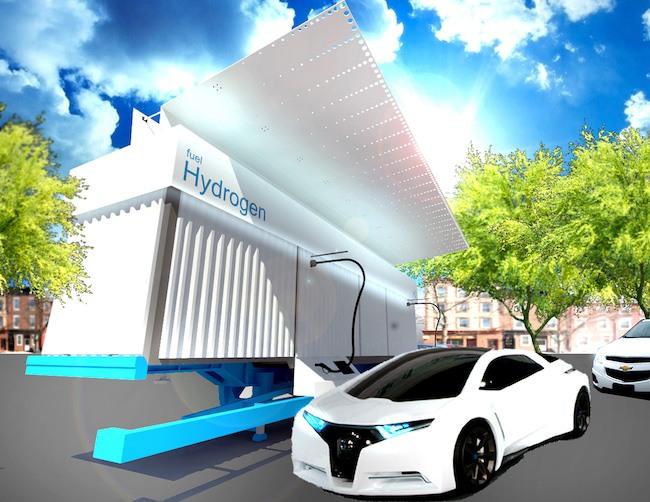
A team of students from Washington State University has taken up one of the biggest challenges of the zero-emission mobility field: how to kickstart the fueling infrastructure for hydrogen fuel cell electric vehicles. If they are successful, existing gas stations all over the country could provide space for fuel cell EV drivers to hook up.
FCEVs produce no airborne emissions, and their fuel can come from biomass and other renewable sources. The problem is that, right now, FCEVs face the same chicken-and-egg dilemma that dogged their battery electric cousins just a few years ago. Namely, where are you going to fuel up?
Hydrogen in a recycled shipping container
Cost is one of the main challenges involved in building commercial-scale hydrogen fueling stations. They come in at $2 million to $4 million a pop. That presents an enormous risk for investors, considering how few FCEVs are on the road right now. That's the angle the WSU team approached. The WSU H2 Refuel Team burst onto the scene back in 2014, when it won an award in an international competition aimed at -- you guessed it -- lowering the cost of fueling stations. An important element that factored into the judging was the pace at which the low-cost design could be developed. Sure enough, just two years later the team is putting all the pieces together and raising funds to build what will become the first hydrogen gas station in Washington state. One cost-saving measure is obvious to the eye. The new fueling station fits into a standard, recycled shipping container. That provides the potential for saving on building materials and shipping costs. Building a fueling station within a modular, transportable footprint also enables economies of scale on the manufacturing end. The real cost saving, though, is in the innovative fueling technology. In the current state of technology, hydrogen gas is compressed into a liquid for use in fuel cells. That adds a large load of expense to the equation. H2 Refuel claims to have developed a workaround based on an inexpensive device called a vortex tube. The basic design has been around since the 1930s, but WSU said the H2 Refuel team is the first to integrate it with hydrogen liquefaction. Vortex tubes work by separating a gas into streams of hot and cold air. They don't have any moving parts. A rapid swirling motion does the trick, by deploying a principle of physics that applies to temperature separation in a moving gas. H2 Refuel anticipates that the vortex-based cooling cycle runs at about a 10th of the pressure of conventional technology. That provides for a longer lifespan as well as the potential for lowering maintenance costs.Renewable hydrogen for Washington state
Until now, the primary source for hydrogen was natural gas, and the primary use of hydrogen in the U.S. is in oil refining and other industrial processes. That leaves little room for truly "clean" personal mobility in the hydrogen field. But the emergence of competitive renewable sources, including water-splitting as well as biomass, has the potential to carve out a space for FCEVs within just a few years. In the U.S., part of the attraction is that states without significant fossil fuel resources can leverage their in-state renewable resources to produce renewable hydrogen. In 2008, for example, WSU took a deep dive into the potential for deploying hydrogen for FCEVs. In addition to noting four large-scale existing facilities producing hydrogen from fossil sources, the report observed:"Hydrogen can be produced through electrolys is using our state’ s wide range of renewable electricity resources," WSU found.And:
"Hydrogen can be produced with digester gas from numerous dairies and waste treatment plants in the state, thereby supplying electrical energy, heat, and fuel for hydrogen vehicles."For now, the H2 Refuel team seams to be focusing on producing hydrogen with biomass from local agricultural waste. WSU's interest in the Wild Horse Wind and Solar Facility indicates that electrolysis (aka water-splitting) with renewable energy may also be on tap. The team is raising funds for a commercial-grade Stirling Cycle precooler, a compressor, an electrolyzer and a fuel dispensing interface, all of which it needs to get a demonstration version of the fueling station up and running. If you'd like to be part of it, you can chip in for as little as $10. Image: via Washington State University

Tina writes frequently for TriplePundit and other websites, with a focus on military, government and corporate sustainability, clean tech research and emerging energy technologies. She is a former Deputy Director of Public Affairs of the New York City Department of Environmental Protection, and author of books and articles on recycling and other conservation themes.














